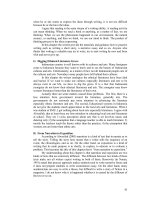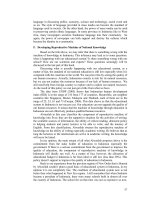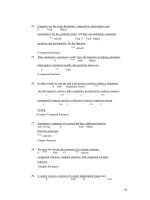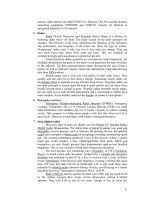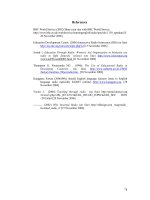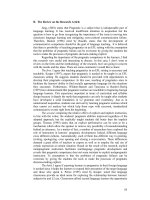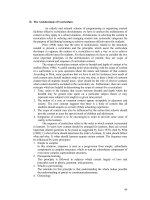Teaching and learning english part 6
Bạn đang xem bản rút gọn của tài liệu. Xem và tải ngay bản đầy đủ của tài liệu tại đây (410.39 KB, 7 trang )
36
Which Students Join Whom?
A Critical Review of O’Connell’s “Group Forming for ESL/ EFL Students”
Junainah Helmi
Introduction
O’Connell proposes a technique to encourage student activity in particularly
speaking class by utilizing group work. The technique which is supported by the use of
cards consisting of questions and answers should be applied in four stages involving the
preparation, demonstration, activity, and feedback. In the preparation stage, the teacher
distributes the cards to each student so that half of the students get cards consisting of
questions and half get the answers. In the
demonstration stage the teacher draw boxes
on the white(or black)board and the students fill in the boxes with the questions and
answers that they have in the cards. In the
activity stage the teacher distributes another
card to each student. Each student asks other students whether they get the answer to
his/ her question in their cards and those who have answers ask other students whether
they have questions whose answers are in their cards. In the
feedback stage the teacher
collects the cards and reaffirm whether the students get the ‘correct’ match.
The technique that has been applied by O’Connell in his EFL class in Japan has
some strength and weaknesses and arouses some questions concerning the technique of
forming the students into groups, the teacher’s role in the classroom and the
implementation for other language skills. Therefore, this essay tries to answer the
questions concerning the technique.
How to Group the Students?
There are some techniques to form the students into groups. While O’Connell
uses the “whole class” as one large group and then divides them into pairs randomly
using the “matching” technique, Vaughn, Hughes, Moody, and Elbaum (2001) proposes
four kinds of students grouping. They are the
whole class, small group, peer pairing,
and one-on-one instruction.
Some teachers may not consider the ‘
whole class’ instruction as a form of group
work, but if we look at the activity done during the teaching and learning process, it can
be viewed as a large group. Consider, for example, what O’Connell has done with his
students. It was an activity that must involve the whole class as the members of the
group. Another example can be seen when teacher and the students discuss a picture in
the beginning of the lesson to build the students’ understanding about the issue they are
going to discuss.
‘Whole class’ instruction is, in my opinion, very important for at least two
reasons.
First, we must make all students in the class involved in the teaching and
learning process. Based on my observation in my classrooms, some students do not give
adequate contribution to the teaching and learning process when they work in groups,
particularly when they have some ‘smart’ students in their group. In such condition,
they will only wait for their friends to speak rather than giving opinions to the
discussion.
Second, sometimes we can save time by utilizing the whole class instruction.
This technique is particularly effective when we discuss something ‘new’. In this case,
we give the students adequate knowledge about the field we are going to discuss, since
37
they haven’t been ready to make a collaborative project through discussions in smaller
groups. Take a stage of the genre-based approach of teaching and learning that is the
Building Knowledge of the Field and the Modelling of Text as an example. These stages
will be more effective if they are presented in the whole class instruction than in smaller
groups since teacher doesn’t need to work more than once with the same theme of
discussion.
Different from the whole class instruction which involves all students in the
classroom in doing one activity, the
small group format may consist only of three, four,
or five students. It is the technique of forming the groups which can cause the students
to have an uncomfortable feeling, and this is what teachers must avoid. Sometimes
teacher asks the students to group them selves. This technique can be beneficial since
the students will work with the person they like. On the contrary, it also brings
disadvantages since there are some students who are not very confident and
unfortunately, they cannot get friends quickly. Sometimes, these students form a group
just because they all cannot join the students who they want. We can imagine what
happens to these students: being in a group of students with the same problem of
inferiority and perhaps, of proficiency also.
To avoid such problem, the teacher must help the students find their group so
that there is no “group of inferiority and proficiency” problem. Technically, the teacher
can ask a student who has this problem, “Budi, have you got a group?” If he answers,
“Not yet,” then the teacher should help him, for example by telling another group,
“Meitha, will you let Budi join your group?”
Peer pairing is still another way of grouping students in the classroom.
Traditionally, this type of group work is done by students who sit nearby, but teacher
can try another way of grouping students into pairs, for example by selecting the
students randomly by utilizing cards as what has been told by O’Connell in this article.
One-on-one instruction, which according to Vaughn, Hughes, Moody, and
Elbaum (2001) is one form of students grouping, is mostly effective for remedial
teaching and for students with learning disabilities. This technique requires the teacher
to be involved very much in the students’ activity meaning that it will take much of his/
her time. Therefore, I suggest that this technique is not used in every day activity. Apart
from its effectiveness, however, I don’t quite agree that this type of instruction is one
form of group work. It is, in my opinion, an individual work.
Students may also be grouped based on their ability or performance. Thus, there
will be groups of
smart students, good students, poor proficiency students, and group of
students with learning disabilities
. This technique of grouping, however, is not
recommended by experts since there are some disadvantages which may appear. The
disadvantages, are, among others, 1) lowers self-esteem and reduces motivation among
poor students, 2) restricts friendship choices, and 3) widens the gap between good
students and the poor ones (Vaughn, Hughes, Moody, and Elbaum, 2001). Considering
the disadvantages above, I suggest that this technique of grouping isnot used in our
classroom.
Implication for Practice
O’Connell’s article is mainly intended for speaking class, so I try to present
other possibilities of utilizing group work for other language skills.
a. In Listening Class
Jun (2000) recommends the use of group work in listening class. The following
is one example of the teaching and learning process in listening class.
First, students are
38
grouped into pairs. Second, the teacher gives each student a picture which is different
from one to another.
Next, one student describes his/ her picture the other student and
he/ she
listens. Finally, the students must change the role.
b. In Speaking Class
As has been discussed in the former paragraph, O’Connell in this article
recommends the use of group work in speaking class. The students are
first given cards
consist of different sentences. Half of the cards consist of questions while the other half
consists of the answers.
Then, the students whose cards contain questions ask other
students using the questions written in the cards (students may read it or speak without
looking at the card) while other students whose cards contain the appropriate answers
speak up. The teacher controls the class.
c. In Reading Class
Vaughn, Hughes, Moody, and Elbaum (2001) propose an example of
implementing group work in reading classes.
First, students are divided into and are
given texts.
Next, students discuss the text, makes summary, and so on. Then, the
teacher gives the students questions and asks one member of each group to answer the
questions.
Finally, the teacher distributes lesson reminder sheets which all students
should complete.
d. In Writing Class
Yusak, M., Rohani, and Hartono (2005) give example of the use of group work
in writing class.
First, students are divided into groups of three and are given
‘incomplete’ text, pictures, jumbled paragraphs, etc. and they discuss it.
Next, the
teacher asks the students to complete the text, create a text based on the pictures,
rearranging the jumbled paragraphs, etc.
Some Advantages and Disadvantages of Group Work
If the teacher can manage the class activity well, there are some advantages that
both students and the teacher can get from group work.
First, this technique can
encourage student activity in the language classroom (O’Connell, 2006). We can see
that some students (especially those who are ‘shy’) will not have enough self-confident
to raise their hands to express their ideas, thoughts, opinions, and so on, but they will
have this kind of feeling when they work in smaller groups.
Second, it can give students
more opportunities to interact with one another (O’Connell, 2006) which later can give
the students ownership in the classroom (Fischman,
/>.). This is a matter of
socialization. Some students may not need this kind of relationship, but some others will
need it to raise their self-confidence, whereas self-confidence is badly needed in
learning a language.
Apart from the advantages above, there are also some disadvantages of group
work. They are, among others,
first, students do the task half-heartedly or not at all.
This condition may happen to ‘passive’ students or students with low motivation and
those with poor proficiency. In this case, the teacher’s control of the class is badly
needed.
Second, when working in groups, some students tend to use their mother tongue
instead of English as the target language. This problem can be anticipated by teacher as
he/she walk around the class and say, for example, “Adi, speak in English, please.”
Third, group work, to some extent, is not very beneficial especially for the teacher since
he/ she must work very hard to control the class. Some students may think that they are
‘free’ from the teacher’s attention when they work in groups so they sometimes just do
not do the task or speak in their mother tongue. In this case, the teacher’s role is very
39
important. This shouldn’t be a problem, however, since teachers indeed, must work very
hard, as proverb says TEACHERS MUST WALK EXTRA MILES.
Conclusion
Having discussed some aspects about group forming for ESL/ EFL students, we
now come to a conclusion that students can be grouped into the whole class group,
small group, peer pairing, or one-on-one instruction by the teacher or by them selves to
do certain task. The forming of group should not be based on their ability/ performance
since there are some disadvantages of this technique of grouping. Regardless their
disadvantages, group work is highly recommended in ESL/EFL classrooms to learn all
language skills since there are some advantages that both teacher and the students can
get by applying this teaching-learning technique.
References
Fischman, Bruce, ____. LEADRERS – Flexible Grouping.
/>Jun, Zhang Yi, 2000. Warm-up Exercises in Listening Classes.
The Internet TESL
Journal, Vol. VI, No. 10, October 2000.
/>ListeningWarm-up.html.
Leys, Jon M., 1999.
Grouping of Students.
/>O’Connell, 2001. Group Forming Activities for ESL/EFL Students.
TESL Journal, Vol.
XII No. 8 August 2006.
/>Vaughn, S, Hughes, M.T., Moody, S.W., and Elbaum, B., 2001.
/>.
Yusak, M., Rohani, and Hartono, R., 2005.
English Texts in Use: A Coursebook for
SMA/MA Students.
Semarang: Aneka Ilmu.
40
You Are Intellectual? Write!
Muhammad Sukrianto
A. Introduction
The book “Pokoknya Menulis” invites the students as the intellectual
candidates and the intellectuals in general to be able to write. The main thing
stressed by the writers in this book is that every ones may be able to write or can
express their ideas through writing. However, the capability of writing can not be
handily had by every ones, it need practice. Indonesian proverb says: “alah bisa
karena biasa.” It means that writing ability can be developed by accustoming to
expressing the ideas through writing.
This book is interesting since it gives solution for them who want to practice
and have a strong ambition to be a good writer. The valuable of this book is the
writers provide the opportunities to the readers to practice directly with the guidance
given in this book. The writers believe that practice is more important than
discussing theories and process is more valuable than product.
According to the writers, what make the students reluctant to write is that
they didn’t get a good learning in writing at school. Most of Indonesian students feel
that writing is difficult and speaking is easier than writing. This phenomenon can be
solved through seriously redesigning the system of education that supports the
subject of writing at schools. In this book the writers provide the strategies and
techniques of writing, theoretically and practically that can help the students to learn
and practice writing.
B. Learning from Past Experience in Facing Future Time
In the first chapter of this book, the writers tell the reader that this book is
written to give solution how to be success becomes a good writer. This book does
not only give how to write theoretically but also give how to write practically. He
believes that after reading and understanding this book, the reader can get a new
inspiration to be a new writer in the future.
The writers also give the guidance how to create a critical thinking. Based on
the phenomena happened in their environment, the students may analyze the
problems and give the solution. By critical thinking concept, the students will be
able to read critically or what we called critical reading. Critical thinking is the
basic of writing. Writing need reading, especially in academic reading because
without reading a lot ones can not write. Critical thinking, as the core of critical
writing, helps students in producing a meaningful written text appropriate to
audience and situation(Schafersman, 1991).
I think that what the writers writes in this chapter is interesting. Learning
from the system of education in the past that didn’t support the students able to
write, it makes us realize the problems that we have to plan the real way to improve
our educational system. It is right that most of students are reluctant to write and
they are shame if what they write is read by his or her friends. It is also my
experience when I teach my students writing. Although it is just writing their daily
activities, they feel difficult to write and what they write is not allowed to read by
others.
In this chapter the writers gives a solution how to write collaboratively
(collaborative writing). Using this technique may help the students to practice

